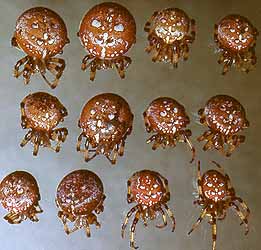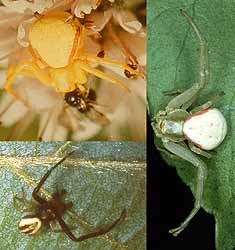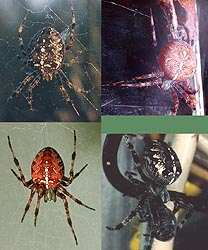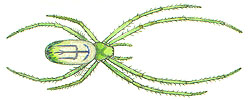 |
|
| You Are Here: Burke Museum : Spider Myths : I.D. : Markings |
Myths about Identifying Spiders
Myth: Spiders are easy to identify.
Fact: No such luck! Laypersons often assume that
there are only a few spider species around, and all they'd need to identify
them would be a few pictures. In reality, the world holds over 50,000 species
of spiders classified into over 100 families. In your local area, there are
likely at least 30 families and a few hundred species.
Even identifying a spider to family is no trivial task; all the many published
keys to spider families are so organized that a beginner will go wrong about
half the time. At species level, one needs an expensive microscope, a library
of hundreds of separate books, monographs and articles, and a few years of experience
to understand the many microscopic details that identify a spider, their similarities,
differences, and variation.
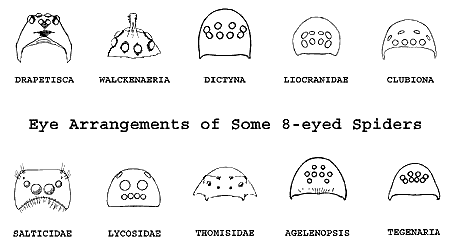 |
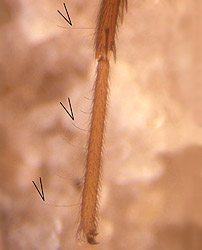 |
|
Eye arrangements: front view of carapace of 5 genera and 5
families of North American spiders, showing eyes. Warning: these
are only examples! There are many other 8-eyed arrangements;
then there are the 6-eyed ones like the "recluse"
group... Click image to enlarge |
End of leg of Cybaeus:
trichobothria (arrows), spines, claws (at end). (from Rod Crawford photo) Click image to enlarge |
| We tell families of spiders (100 worldwide, perhaps 30 in a given area) apart by characters like those above: eye arrangements, arrangement of trichobothria (special thin sensory hairs), spines, and the claws at the ends of the legs. | |
Myth: Spider species are distinguished and identified by "markings."
Fact: No, they're not. Spiders do not come color-coded
for our benefit. Imagine trying to identify the make and model of a car...by
the color!
Spiders are identified by structure. They are classified into families by the
arrangement of the eyes (see above), number of claws, location and arrangement
of certain specialized hairs and spines (see above), structure and arrangement
of the spinnerets (silk spinning organs at rear end), and other characters that
you cannot see with the naked eye. Within families, species are separated mostly
by the fine structure of the sex organs (yes, really, I'm not kidding! see below),
which can't be seen without high magnification.
Color patterns can be very variable within species, and very similar between
different species. For example, the majority of all spider species can be seen
as having a "violin" shape somewhere on their bodies; thousands of species have
a pattern of "chevrons" on the abdomen. These and other pattern features do
not indicate any particular species, and are not signs of danger to humans.
There are exceptions to this rule; a very small number of species do have distinctive
pattern elements; but in general, to recognize a spider by naked-eye appearance
one must first know all, or almost all, the hundreds of species that live in
your locality, their similarities, differences, and variability. Even then,
you must usually have a microscope to do more than guess at the spider's identity.
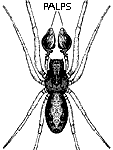 |
 |
 |
 |
 |
| Male Dictyna sublata showing palps from above |
Dictyna sublata left palp from below |
Dictyna suprenans left palp from below |
Dictyna maxima left palp from below |
Dictyna zaba left palp from below |
|
Could you identify them? In North America are about
150 species of Dictyna, a genus (split into smaller groups by some) of small
spiders. Many, like Dictyna sublata (left),
are only about 3 mm long. The whole bodies of most Dictyna look almost
exactly alike and the differences are in the male and female sex organs,
which are similar but not identical to each other; see male palps of 4 related
species above.
Could you pick out these 4 species from the 145 other Dictyna? How about without a microscope? |
||||
| Previous Myth | Myths Home | Web Resources | Next Myth |
 |
Text ©
2003, Burke Museum of Natural History & Culture, University of Washington, Box 353010, Seattle, WA 98195, USA Phone: 206-543-5590 Photos © as credited |
Queries
to Spider Myths author, Rod Crawford This page last updated 1 September, 2010 This site best viewed at 800 x 600 using IE 5.0 or above. |
